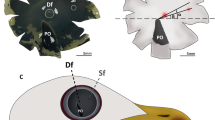Summary
The pecten oculi of the sparrow consists of capillaries, pigment cells and a superficial membrane. Because of the loose structure of the first two components broad intercellular spaces occur in the pecten. The capillary wall consists of endothelial cells and a perivascular membrane. The bodies of the endothelial cells are flattened, while the plasmalemma of both their surfaces (basal and luminal) is strongly folded and forms numerous microfolds with an average thickness of 700 Å. The height of the inner microfolds is 1.4–1.8 μm, the outer microfolds measure 1.3–1.6 μm. They lie densely packed side by side and are separated by recesses of the capillary lumen ca. 500 Å wide. Due to this the surface of the endothelial cell is increased by approximately 20-fold. The adjoining endothelial cells abut or overlap with margins, and are joined by the zonulae adherentes. Pigment cells form numerous processes and microvilli. Some rest on the capillary walls, while others penetrate the superficial membrane of the pecten or fill the intercellular spaces.
Similar content being viewed by others
References
Bruns, R. R., Palade, G. E.: Studies on blood capillaries. I. General organization of blood capillaries in muscle. J. Cell Biol. 37, 244–276 (1968a)
Bruns, R. R., Palade, G. E.: Studies on blood capillaries. II. Transport of ferritin molecules across the wall of muscle capillaries. J. Cell Biol. 37, 277–299 (1968b)
Clementi, F., Palade, G. E.: Intestinal capillaries. I. Permeability to peroxidase and ferritin. J. Cell Biol. 41, 33–58, (1969)
Karnovsky, M. J.: The ultrastructural basis of capillary permeability studied with peroxidase as a tracer. J. Cell Biol. 35, 213–236 (1967)
Kauth, H., Sommer, H.: Das Ferment Kohlensäureanhydrase im Tierkörper. IV. Über die Funktion des Pecten im Vogelauge. Biol. Zbl. 72, 196–209 (1953)
Leiner, M.: Über die Bedeutung des Pecten im Vogelauge. Verh. dtsch. zool. Ges., Suppl. 15, 117–123 (1951)
Luft, J.: Improvement in epoxy resin embedding methods. J. biophys. biochem. Cytol. 6, 409 (1961)
O'Rahilly, R., Meyer, D. B.: The development and histochemistry of the pecten oculi. In: The structure of the eye (G. K. Smelser, ed.), p. 207–219. New York-London: Academic Press 1961
Palade, G. E.: Fine structure of blood capillaries. J. appl. Phys. 24, 1424 (1953)
Palade, G. E., Bruns, R. R.: Structural modulations of plasmalemmal vesicles. J. Cell Biol. 37, 633–649 (1969)
Pappenheimer, J. R., Renkin, E. M., Borrero, L. M.: Filtration, diffusion and molecular sieving through peripheral capillary membranes. Amer. J. Physiol. 167, 13–14 (1951)
Reese, T. S., Karnovsky, M. J.: Fine structural localization of a blood-brain barrier to exogenous peroxidase. J. Cell Biol. 34, 207–217 (1967)
Reynolds, E. S.: The use of lead citrate at high pH as an electron-opaque stain in electron microscopy. J. Cell Biol. 17, 208–212 (1963)
Richardson, K. C., Jarett, L., Finke, E.: Embedding in epoxy resins for ultrathin sectioning in electron microscopy. Stain Technol. 35, 313–323 (1960)
Sabatini, D. D., Bensch, K., Barrnett, R. J.: Cytochemistry and electron microscopy. The preservation of cellular ultrastructure and enzymatic activity by aldehyde fixation. J. Cell Biol. 17, 19–58 (1963)
Schneeberger-Keeley, E. E., Karnovsky, M. J.: The ultrastructural basis of alveolar capillary membrane permeability to peroxidase used as a tracer. J. Cell Biol. 37, 781–793 (1968)
Seaman, A. R.: A correlated light and electron microscope study of the pecten oculi in the adult chicken (Gallus domesticus). Anat. Rec. 142, 277–278 (1962)
Seaman, A. R., Himelfarb, T. M.: Correlated ultrafine structural changes of the avian pecten oculi and ciliary body of Gallus domesticus. Amer. J. Ophthal. Ser. 3, 56, 278–296 (1963)
Seaman, A. R., Storm, H.: A correlated light and electron microscope study on the pecten oculi of the domestic fowl (Gallus domesticus). Exp. Eye Res. 2, 163–172 (1963)
Slonaker, J. R.: A physiological study of the anatomy of the eye and its accessory parts of the English sparrow (Passer domesticus). J. Morph. 31, 351–459 (1918)
Slonaker, J. R.: The development of the eye and its accessory parts in the English sparrow (Passer domesticus). J. Morph. 35, 263–357 (1921)
Tanaka, A.: Electron microscopic study of the avian pecten. Zool. Mag., Tokyo 69, 314–317 (1960)
Welsch, U.: Enzymhistochemische und feinstrukturelle Beobachtungen am Pecten oculi von Taube (Columba livia) und Lachmöwe (Larus ridibundus). Z. Zellforsch. 132, 231–244 (1972)
Wingstrand, K. G., Munk, O.: The pecten oculi of the pigeon with particular regard to its function. Biol. Skr. Dan. Vid. Selsk. 14, 1–64 (1965)
Author information
Authors and Affiliations
Rights and permissions
About this article
Cite this article
Jasiński, A. Fine structure of capillaries in the pecten oculi of the sparrow, Passer domesticus . Z.Zellforsch 146, 281–292 (1973). https://doi.org/10.1007/BF00307352
Received:
Accepted:
Issue Date:
DOI: https://doi.org/10.1007/BF00307352




